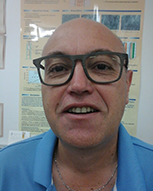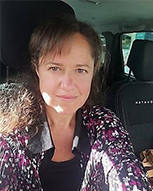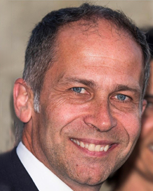
|
|
|
Programme Scientifique > Conférenciers Invités

 Didier LE CERF
Didier LE CERF
Thème : Les amphiphiles et les systèmes biosourcés
Didier Le Cerf est Professeur de Chimie à l’Université de Rouen Normandie, où il enseigne la thermochimie, les réactions chimiques et la physico-chimie des polymères. Coté recherche, il est directeur-adjoint du laboratoire "Polymères Biopolymères Surfaces" UMR 6270 CNRS, Université de Rouen Normandie et INSA de Rouen Normandie et responsable de l'équipe "Systèmes Colloïdaux Complexes".
Ses activités de recherche portent principalement sur la conception et la caractérisation de systèmes complexes adaptatifs et stimuli sensibles (température, pH, lumière) à base de polysaccharides (modifiés ou non) obtenus par auto-assemblage en solution ou par réticulation.
 Jutta RIEGER
Jutta RIEGER
Thème : Les amphiphiles et leurs organisations
Jutta Rieger received her PhD from the University of Liège (Belgium) and the University of Grenoble (France). After a postdoctoral fellowship at ICMMO (Orsay, France) in collaboration with Macopharma, she joined the LCP at UPMC (now Sorbonne University) and started working on RAFT polymerization in heterogeneous media. Since 2009 she is an independent CNRS researcher at IPCM in the same insititution.
Her current research focuses on the synthesis of functional polymeric materials using homogeneous or heterogeneous controlled radical polymerization processes, and in particular on polymerization-induced self-assembly (PISA). She is the (co-)author of more than 65 articles and 5 book chapters.
 Catherine LADAVIERE
Catherine LADAVIERE
Thème : Les amphiphiles et leurs organisations
Dr Catherine Ladavière is CNRS research director. She received her PhD in Polymer chemistry from Lyon 1 University in 1998. She performed her research at the Life Science interface in the joint research team CNRS/bioMérieux (ENS Lyon) during 7 years. She works now at IMP (UMR CNRS 5223, La Doua, Villeurbanne) where she obtained her HDR in 2010.
Dr Ladavière has been involved in academic (e.g., as coordinator of ANTIDOTE project ANR-2016) and industrial collaborations as with bioMérieux, Sanofi Pasteur, or Bayer CropScience. Her research scope is focused on the design and the physicochemical behavior of lipid layer/polymer nanoparticle assemblies, as well as liposome/polymer hydrogel devices, the both valorized as delayed-release biosystems.
She has also a strong expertise in physicochemical characterization of polymers in solution, colloids in suspension, and structural analyses of macromolecules by MALDI-TOF mass spectrometry.

Didier GIGMES
Thème : Les amphiphiles et leurs synthèses
Didier Gigmes completed his PhD in organic chemistry in 1998 under the supervision of Prof. Paul Tordo at the University Paul Cézanne in Marseille (France). Then he moved to Elf Atochem North America in Pennsylvania (USA) as a post-doctoral fellow to work in the field of the controlled radical polymerization.
In 2001, he was recruited as CNRS researcher to develop the nitroxide-mediated polymerization technique. In October 2010, he was appointed Research Director from the CNRS working at Aix-Marseille University (France).
Currently, his main concerns with his group are focused on the development and use of new methodologies for the synthesis of advanced polymer materials finding applications in the fields of energy and health.
Recently he was also involved in the development of original methodologies for Nitroxide Mediated Photopolymerization and the synthesis of versatile photoinitiators. So far DG is (co)author of 350 peer review articles in international journals, 20 patents, 13 book chapters and editor of one book on NMP. Since 2012, he is heading the Institute of radical chemistry that is located in Marseille (France).
 Sébastien LECOMMANDOUX
Sébastien LECOMMANDOUX
Thème : Les amphiphiles et leurs applications
Sébastien Lecommandoux is Full Professor at the University of Bordeaux (Bordeaux-INP). He is Director of the Laboratoire de Chimie des Polymères Organiques (LCPO-CNRS) and is leading the group “Polymers Self-Assembly and Life Sciences”.
His research interests include polypeptide and polysaccharide based block copolymers self-assembly, the design of polymersomes for drug-delivery and theranostic, as well as biomimetic approaches toward design of synthetic viruses and artificial cells.
He published more than 180 publications in international journal, 6 book chapters and 9 patents (2 being licenced), with over 12000 citations (h-factor 56, Google Scholar).
Sébastien Lecommandoux is recipient of the CNRS bronze medal (2004), Institut Universitaire de France Junior Chair (IUF 2007), Fellow of the Royal Society of Chemistry RSC (2017), Seqens Award of the French Academy of Science (2019).
He is Associate Editor of Biomacromolecules (ACS) since 2013 and in the Editorial Advisory Board of several international journals, including Bioconjugate Chemistry (ACS), Polymer Chemistry and Biomaterials Science (RSC).
More information: http://www.lcpo.fr/3-polymer-self-assembly-life-sciences/
 Elise DENIAU
Elise DENIAU
Atelier : Diffusion dynamique et statique de la lumière
Elise DENIAU received her PhD in chemistry and physical-chemistry of polymers from the University of Le Mans (France) at the laboratory of Polymers, Colloids and Interface (now IMMM, UMR6283) in 2010.
Subsequently, she joined the Macroarc Group of Pr. Barner-Kowollik at Karlsruhe Institute of Technology (KIT, Germany) as a post-doctoral fellow.
In 2012, she became an assistant professor at the University of Pau (UPPA, France) in the Institute of Analytical Sciences and Physico-chemistry for Environment of Materials (IPREM, UMR5254). She currently focuses on the controlled synthesis and self-assembly of amphiphilic polymers with tuneable properties.
 Annie BRÛLET
Annie BRÛLET
Atelier : Diffusion des neutrons
Après une thèse de Thèse Docteur Ingénieur au Centre de Recherches sur les Macromolécules à Strasbourg, sur la « Déformation d’un polymère semi-cristallin, le polypropylène : étude de la conformation des chaînes de polymères par diffusion de neutrons aux petits angles », A. Brûlet a intégré le LLB afin de travailler sur la structure de matériaux notamment des gels de polymères par diffusion de neutrons aux petits angles (DNPA).
Elle s’est ensuite intéressée à la structure de polymères cristaux liquide (PCL), linéaires tout d’abord en montrant l’existence de repliement en épingles à cheveux prédite par Pierre Gilles de Gennes puis à des polymères en peigne qui ont montré des propriétés élastiques significatives bien que non enchevêtrés reliées à la spécificité de la structure peigne.
Elle s’est ensuite spécialisée dans la technique d’échos de spin de neutrons qui permet de mesurer les propriétés dynamiques à des échelles de temps de 1 à quelques centaines de nanosecondes, qui sont les temps caractéristiques de fluctuations de membranes lipidiques ou de polymères en solutions ou à l’état fondu (Rouse Zimm, reptation).
Elle est spécialisée dans la conformation de polymères à l’état fondu (déformation, confinement dans des films ultra-minces, PCL) d’hydrogels, de matériaux composites et ou complexes.
Annie Brûlet étudie maintenant des block copolymères auto-assemblés, principalement des polymeromes, avec les équipes du LCPO à Bordeaux, de l’ENSCP à Paris, du LCPM à Nancy… Récemment elle s’est tournée vers des problématiques de digestion de gels de protéines végétales.
Elle est spécialiste internationale en diffusion aux petits angles (Neutrons et Rayons-X). En 2018, elle a reçu avec une équipe « Petits Angles » du LLB le Cristal collectif du CNRS.
Avec le soutien de notre partenaire Trace Analysis
| Personnes connectées : 16 | Vie privée |

|

